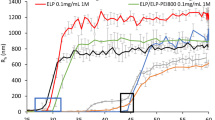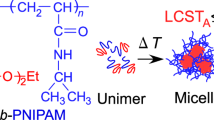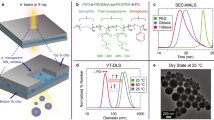Abstract
The synthesized linear poly(N-methylethylene imine) (PMEI; weight-average molecular weight, 26 kDa) has been characterized in terms of its solubility, titration behavior, lower critical solution temperature (LCST)- and upper critical solution temperature (UCST)-type phase separations, self-aggregation and aggregation behaviors with polystyrene (PS) latex particles. PMEI is soluble in several solvents (that is, from nonpolar n-hexane above 45 °C to polar water at room temperature) and exhibits a UCST-type phase separation in toluene at 36 °C. The pKa value of PMEI is 7.28. An aqueous PMEI solution exhibited LCST-type phase behavior, and the LCST was determined to be 116 °C with the aid of the salting out effect. PMEI chains formed aggregates with negatively charged PS latex particles, and the aggregate structure was dependent on the PMEI concentration. In the vicinity of the isoelectric point, the PMEI-PS aggregates grew larger and precipitated, and at higher PMEI concentrations, the aggregates were positively charged and uniformly dispersed. In conclusion, PMEI is expected to be used as a highly hydrophilic and versatile polycation.
Similar content being viewed by others

Log in or create a free account to read this content
Gain free access to this article, as well as selected content from this journal and more on nature.com
or
References
Boussif, O., Lezoualc’h, F., Zanta, M. A., Mergny, M. D., Scherman, D., Demeneix, B. & Behr, J.-P. A versatile vector for gene and oligonucleotide transfer into cells in culture and in vivo: polyethyleneimine. Proc. Natl Acad. USA 92, 7297–7301 (1995).
Bertschinger, M., Backliwal, G., Schertenleib, A., Jordan, M., Hacker, D. L. & Wurm, F. M. Disassembly of polyethylenimine-DNA particles in vitro: implications for polyethylenimine-mediated DNA delivery. J. Control. Release 116, 96–104 (2006).
Wagner, E. & Kloeckner, J. Gene delivery using polymer therapeutics. Adv. Polym. Sci. 192, 135–173 (2006).
Al-Dosari, M. S. & Gao, X. Nonviral gene delivery: principle, limitation, and recent progress. AAPS J. 11, 671–681 (2009).
Kay, M. A. State-of-the-art gene-based therapies: the road ahead. Nat. Rev. Genet. 12, 316–328 (2011).
Lin, Y., Yan, Q., Kong, C. & Chen, L. Polyethyleneimine incorporated metalorganic frameworks adsorbent for highly selective CO2 capture. Sci. Rep. 3, 1859 (2013).
Zhang, W., Liu, H., Sun, C., Drage, T. C. & Snape, C. E. Capturing CO2 from ambient air using a polyethyleneimine-silica adsorbent in fluidized beds. Chem. Eng. Sci. 116, 306–316 (2014).
Sasanuma, Y., Hattori, S., Imazu, S., Ikeda, S., Kaizuka, T., Iijima, T., Sawanobori, M., Azam, M. A., Law, R. V. & Steinke, J. H. G. Conformational analysis of poly(ethylene imine) and its model compounds: rotational and inversional isomerizations and intramolecular and intermolecular hydrogen bonds. Macromolecules 37, 9169–9183 (2004).
Sasanuma, Y., Kumagai, R. & Nakata, K. Prediction of structures, properties, and functions of alternating copolymers of ethylene imine and ethylene oxide as an example of molecular design for polymers. Macromolecules 39, 6752–6764 (2006).
Tanaka, R., Ueoka, I., Takaki, Y., Kataoka, K. & Saito, S. High molecular weight linear poly(ethyleneimine) and poly(N-methylethyleneimine). Macromolecules 16, 849–853 (1983).
Saegusa, T., Ikeda, H. & Fujii, H. Crystalline polyethyleneimine. Macromolecules 5, 108–108 (1972).
Polysciences 2014–2015 Catalog 222–223 (Polysciences, Inc., Warrington, PA, USA, 2014).
Poly(ethylene glycol) Chemistry and Biological Applications (eds Harris J. M. & Zalipsky S.) (American Chemical Society, Washington, DC, USA, 1997).
Abe, A., Furuya, H., Mitra, M. K. & Hiejima, T. The polyoxyethylene chain-on the origin of its conformational flexibility. Comput. Theor. Polym. Sci. 8, 253–258 (1998).
Sasanuma, Y., Ohta, H., Touma, I., Matoba, H., Hayashi, Y. & Kaito, A. Conformational characteristics of poly(ethylene sulfide) and poly(ethylene oxide): solvent dependence of attractive and repulsive gauche effects. Macromolecules 35, 3748–3761 (2002).
Sasanuma, Y. & Sugita, K. The attractive gauche effect of ethylene oxide. Polym. J. 38, 983–988 (2006).
Water Soluble Polymers: Solution Properties and Applications (ed. Amjada Z.) (Springer, New York, USA, 1998).
Lambermont-Thijs, H. M. L., Bonami, L., Du Prez, F. E. & Hoogenboom, R. Linear poly(alkyl ethylene imine) with varying side chain length: synthesis and physical properties. Polym. Chem 1, 747–754 (2010).
Brant, D., Miller, W. G. & Flory, P. J. Conformational energy estimates for statistically coiling polypeptide chains. J. Mol. Biol. 23, 47–65 (1967).
Flory, P. J. Statistical Mechanics of Chain Molecules, (Wiley & Sons, New York, USA, 1969).
Mattice, W. L. & Suter, U. W. Conformational Theory of Large Molecules: The Rotational Isomeric State Model in Macromolecular Systems, (Wiley & Sons, New York, USA, 1994).
Sasanuma, Y., Teramae, F., Yamashita, H., Hamano, I. & Hattori, S. Conformational analysis of poly(trimethylene imine) and poly(N-methyltrimethylene imine) by the rotational isomeric state scheme with up to fourth-order intramolecular interactions. Macromolecules 38, 3519–3532 (2005).
Flory, P. J. Stereochemical equilibrium in chain molecules. J. Am. Chem. Soc. 89, 1798–1804 (1967).
Sasanuma, Y., Ogawa, Y. & Matsumoto, M. Predictive elucidation of conformational characteristics and configurational properties of poly(1-methylphosphirane) and poly(1- phyenylphosphirane) as a molecular design. Phys. Chem. Chem. Phys. 12, 14619–14628 (2010).
Sasanuma, Y. Conformational analysis of poly(propylene oxide) and its model compound 1,2-dimethoxypropane. Macromolecules 28, 8629–8638 (1995).
Brissault, B., Kichler, A., Guis, C., Leborgne, C., Danos, O. & Cheradame, H. Synthesis of linear polyethylenimine derivatives for DNA transfection. Bioconjug. Chem. 14, 581–587 (2003).
Shultz, A. R. & Flory, P. J. Phase equilibria in polymer-solvent system. J. Am. Chem. Soc. 74, 4760–4767 (1952).
Cortez, M. A., Godbey, W. T., Fang, Y., Payne, M. E., Cafferty, B. J., Kosakowska, K. A. & Grayson, S. M. The synthesis of cyclic poly(ethylene imine) and exact linear analogues: an evaluation of gene delivery comparing polymer architectures. J. Am. Chem. Soc. 137, 6541–6549 (2015).
Tanaka, R., Koike, M., Tsutsui, T. & Tanaka, T. Synthesis of linear poly(N- methylethyleneimine) and related polymers by reductive N-methylation. J. Polym. Sci., Polym. Lett. Ed. 16, 13–19 (1978).
Berry, G. C. Thermodynamic and conformational properties of polystyrene. I. Light- scattering studies on dilute solutions of linear polystyrenes. J. Chem. Phys. 44, 4550–4564 (1966).
Zimm, B. H. Apparatus and methods for measurement and interpretation of the angular variation of light scattering; preliminary results on polystyrene solutions. J. Chem. Phys. 16, 1099–1116 (1948).
Warakomski, J. M. & Thill, B. P. Evidence for long chain branching in polyethyloxazoline. J. Polym. Sc. A Polym. Chem. 28, 3551–3563 (1990).
Flory, P. J. Principles of Polymer Chemistry, (Cornell University Press, Ithaca, NY, USA, 1953).
Teraoka, I. Polymer Solutions: An Introduction to Physical Properties, (John Wiley & Sons, New York, USA, 2002).
Fujita, H. A new method of treating light-scattering data on dilute polymer solutions. Polym. J. 1, 537–541 (1970).
Akita, S., Einaga, Y., Miyaki, Y. & Fujita, H. Solution properties of poly(D-β-hydroxybutyrate). 1. Biosynthesis and characterization. Macromolecules 9, 774–780 (1976).
Po, H. N. & Senozan, N. M. The Henderson-Hasselbalch equation: its history and limitations. J. Chem. Educ. 78, 1499–1503 (2001).
Carpino, L. A. & El-Faham, A. Effect of tertiary bases on O-benzotriazolyluronium salt-induced peptide segment coupling. J. Org. Chem. 59, 695–698 (1994).
Smits, R. G., Koper, G. J. M. & Mandel, M. The influence of nearest- and next-nearest- neighbor interactions on the potentiometric titration of linear poly(ethylenimine). J. Phys. Chem. 97, 5745–5751 (1993).
Borkovec, M., Koper, G. J. M. & Piguet, C. Ion binding to polyelectrolytes. Curr. Opin. Colloid Interface Sci. 11, 280–289 (2006).
Griffiths, P. C., Paul, A., Stilbs, P. & Petterson, E. Charge on poly(ethylene imine): comparing electrophoretic NMR measurements and pH titrations. Macromolecules 38, 3539–3542 (2005).
Nagaya, J., Homma, M., Tanioka, A. & Minakata, A. Relationship between protonation and ion condensation for branched poly(ethylenimine). Biophys. Chem. 60, 45–51 (1996).
Mészéros, R., Thompson, L., Bos, M. & de Groot, P. Adsorption and electrokinetic properties of polyethylenimine on silica surfaces. Langmuir 18, 6164–6169 (2002).
Koper, G. J. M., van Duijvenbode, R. C., Stam, D. D. P. W., Steuerle, U. & Borkovec, M. Synthesis and protonation behavior of comblike poly(ethyleneimine). Macromolecules 36, 2500–2507 (2003).
Weber, C., Hoogenboom, R. & Schubert, U. S. Temperature responsive bio-compatible polymers based on poly(ethylene oxide) and poly(2-oxazoline)s. Prog. Polym. Sci. 37, 686–714 (2012).
Polik, W. F. & Burchard, W. Static light scattering from aqueous poly(ethylene oxide) solutions in the temperature range 20–90 °C. Macromolecules 16, 978–982 (1983).
Xu, R., Winnik, M. A., Hallett, F. R., Riess, G. & Croucher, M. D. Light-scattering study of the association behavior of styrene-ethylene oxide block copolymers in aqueous solution. Macromolecules 24, 87–93 (1991).
Acknowledgements
We thank Mr Kenta Kato (DJK Corporation) for performing the SEC measurement; the late Dr Joachim H. G. Steinke (Imperial College, UK) for visiting us to give valuable advice on the polymer synthesis; and Dr Kayori Takahashi, Dr Haruhisa Kato and Dr Shinichi Kinugasa (National Institute of Advanced Industrial Science and Technology) for helpful advice on the SLS experiment. This study was partially supported by the Grants-in-Aid for Scientific Research (B) (18350112) and (C) (22550190 and 16K05906) from the Japan Society for the Promotion of Science.
Author information
Authors and Affiliations
Corresponding author
Ethics declarations
Competing interests
The authors declare no conflict of interest.
Additional information
Supplementary Information accompanies the paper on Polymer Journal website
Supplementary information
Rights and permissions
About this article
Cite this article
Fukuda, Y., Abe, D., Tanaka, Y. et al. Solution properties of poly(N-methylethylene imine), a highly hydrophilic polycation. Polym J 48, 1065–1072 (2016). https://doi.org/10.1038/pj.2016.71
Received:
Revised:
Accepted:
Published:
Issue date:
DOI: https://doi.org/10.1038/pj.2016.71


